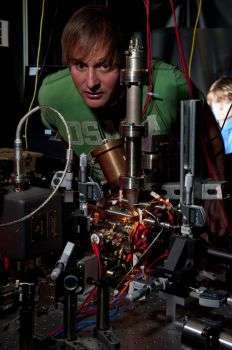Scientists take a quieter step closer to first practical quantum computer

(Phys.org) —Scientists working to produce the world's fastest, most powerful computers have moved a step closer to creating a practical prototype using microwaves – by shielding the atoms driving this new generation of computers from the harmful effects of noise.
Microwaves are already used in smart phone technology, but scientists are now looking at how they can harness microwaves so that atomic particles can be used to store and process data on a new type of computer called a quantum computer.
The ability to store and process huge amounts of data in a quantum way (on an atomic scale) would revolutionise computing, making it possible to carry out massive calculations and enabling computers to understand chemical reactions, create new medicines and carry out seemingly impossible simulations, such as the creation of our universe.
To build a quantum computer, scientists trap electrically charged atoms (ions) and control them so that they can be harnessed to form the "atomic highways" that would build the computer network.
The first small-scale ion trap quantum computers have already been built using lasers to carry out calculations within the 'quantum processor', but the number of lasers needed to make a large-scale quantum computer would make this a substantial engineering challenge.
A new generation of quantum computers is now being devised utilising microwaves instead, which are easier to use and which should bring the construction of a large-scale ion-trap quantum-information processor much closer.
But there is a problem.
The quantum effects that give a quantum computer its tremendous power (such as quantum superposition, where a single object can be at two different places simultaneously) are easily destroyed by any external noise.
Now, Dr Winfried Hensinger, along with postdoctoral fellow Simon Webster and PhD students Seb Weidt, Kim Lake and James McLoughlin, who form part of Dr Hensinger's Sussex Ion Quantum Technology Group, have come up with an extremely efficient and easy way to shield the quantum computer from external noise, effectively enabling large-scale operation of a microwave quantum computer. Their paper is published in the journal, Physical Review Letters (04 October 2013).
By applying a special combination of microwaves and radio frequency fields, the team were able to modify the atoms so that they became more resilient to external noise.
Dr Hensinger says: "While large scale quantum computers might be still 10-30 years away, we have now managed to clear another big hurdle and we are highly excited about the opportunities that arise from this discovery.
"The most groundbreaking applications of quantum computers are not even known yet. When classical computers were first invented, nobody anticipated the way they would transform society. In the same way, because of the unbelievable power of quantum computers, predictions are difficult to make and we can only begin to imagine how they will change our lives."
More information: Webster, S. et al. Simple Manipulation of a Microwave Dressed-State Ion Qubit, Phys. Rev. Lett. 111, 140501 (2013). prl.aps.org/abstract/PRL/v111/i14/e140501
Journal information: Physical Review Letters
Provided by University of Sussex












.jpg)






